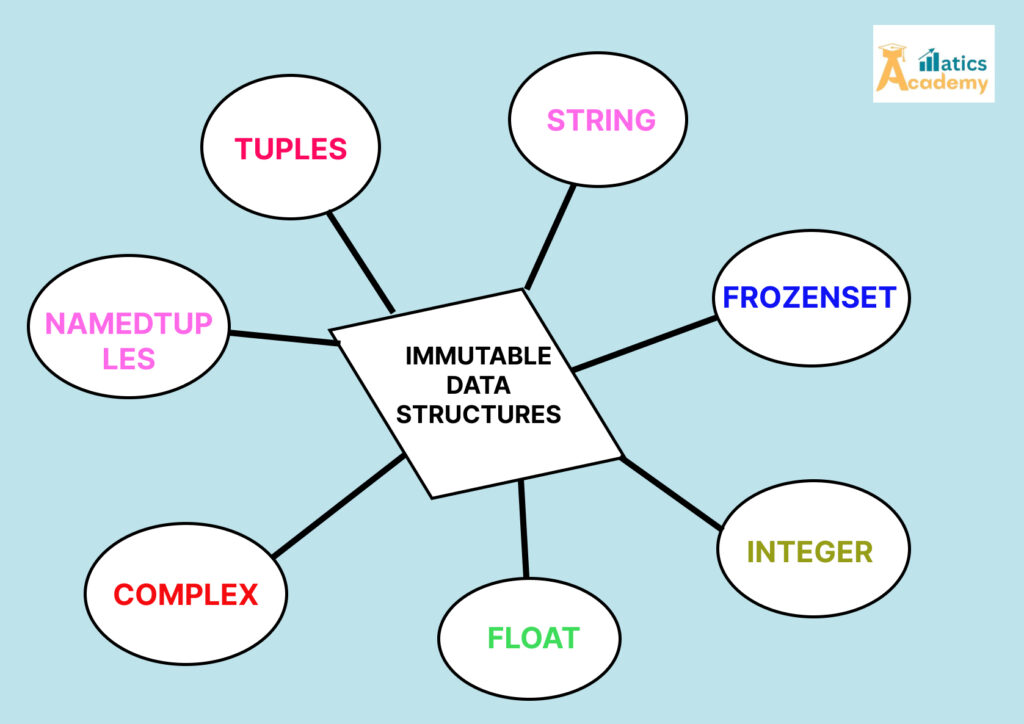Immutable data structures are foundational concepts in Python programming. These structures ensure data integrity by preventing modifications once created, making them essential for building secure and efficient applications. This guide delves into the concept of immutability, its importance, examples, advantages, disadvantages, and top interview questions to ace your next interview.
What Are Immutable Data Structures?
Immutable data structures are those whose state cannot be changed after creation. Any attempt to modify them results in the creation of a new object rather than altering the original. In Python, common immutable data structures include:
- Tuples
- Strings
- frozenset
- int, float, complex
- Namedtuples

Why Use Immutable Data Structures?
- Data Integrity: Prevent accidental modifications.
- Thread-Safety: Ideal for concurrent programming since they avoid race conditions.
- Hashability: Can be used as keys in dictionaries or elements in sets.
- Predictability: Simplifies debugging and testing.
Popular Immutable Data Structures in Python
1. Tuples
Tuples are ordered collections of elements. Unlike lists, tuples are immutable.
my_tuple = (1, 2, 3) # Attempting to modify results in an error # my_tuple[1] = 5 # Raises TypeError
2. Strings
Strings are immutable sequences of characters.
my_string = "Python" # Concatenation creates a new object new_string = my_string + " is fun"
3. frozenset
A frozenset is an immutable version of a set.
my_set = frozenset([1, 2, 3]) # Adding elements is not allowed # my_set.add(4) # Raises AttributeError
4. Namedtuple
Namedtuples provide immutability with readability, acting as lightweight data structures.
from collections import namedtuple
Point = namedtuple('Point', ['x', 'y'])
p1 = Point(2, 3)
# p1.x = 5 # Raises AttributeError
Advantages of Immutable Data Structures
- Predictable Behavior: No side effects from unintended mutations.
- Thread-Safe: Excellent for multi-threaded applications.
- Ease of Testing: Simplifies debugging due to fixed states.
- Hashable: Can be used in hash-based collections like dictionaries.
- Memory Efficiency: Shared objects can reduce memory usage.
Disadvantages of Immutable Data Structures
- Overhead of Copying: Modifications require creating new objects, which can be resource-intensive.
- Limited Flexibility: Not suitable for all scenarios, especially when frequent updates are needed.
- Learning Curve: May be challenging for beginners to grasp their usage.
Common Use Cases of Immutable Data Structures
- Configuration Data: Store constant settings or default parameters.
- Keys in Dictionaries: Ensure that keys do not change and remain consistent.
- Functional Programming: Use in pure functions to avoid side effects.
- Concurrency: Share immutable data across threads safely.
Best Practices for Using Immutable Data Structures
- Prefer Over Mutable Types: Use immutable types when data doesn’t require modification.
- Combine with Generators: Use generators to process large immutable datasets efficiently.
- Leverage Libraries: Use libraries like
pyrsistentfor advanced immutable data structures.
Advanced Concepts
1. Immutability in Functional Programming
Functional programming heavily relies on immutability to avoid side effects and maintain pure functions.
# Example of pure function
def add_value(tuple_data, value):
return tuple_data + (value,)
data = (1, 2, 3)
new_data = add_value(data, 4)
print(new_data) # Output: (1, 2, 3, 4)
2.Creating Custom Immutable Classes
class ImmutablePoint:
__slots__ = ('x', 'y')
def __init__(self, x, y):
object.__setattr__(self, 'x', x)
object.__setattr__(self, 'y', y)
def __setattr__(self, name, value):
raise AttributeError("Cannot modify immutable instance")
p = ImmutablePoint(3, 4)
# p.x = 5 # Raises AttributeError
Conclusion
Understanding immutable data structures in Python is vital for building robust, secure, and efficient applications. These structures are particularly valuable in functional programming, multi-threaded environments, and hash-based collections. By leveraging immutability effectively, developers can write cleaner, more predictable, and maintainable code.
Interview Questions
1. What is the main advantage of immutable data structures?
Company: Google
Answer: They prevent unintended modifications, ensuring data integrity and thread safety.
2. Can you modify elements within an immutable object?
Company: Microsoft
Answer: No, immutable objects cannot be modified. Any operation attempting to modify creates a new object.
3. How does Python handle immutability with strings?
Company: Amazon
Answer: Strings in Python are immutable, so concatenation or slicing operations create new string objects instead of modifying the original.
4. Why are immutable objects hashable?
Company: Meta (Facebook)
Answer: Immutable objects have a fixed hash value since their state does not change, making them suitable for hash-based collections like dictionaries and sets.
5. How can you implement immutability in a custom Python class?
Company: Oracle
Answer: Use the __setattr__ method to prevent attribute modification and __slots__ to limit attributes.
QUIZZES
Immutable Data Structures Quiz
Question
Your answer:
Correct answer:
Your Answers
